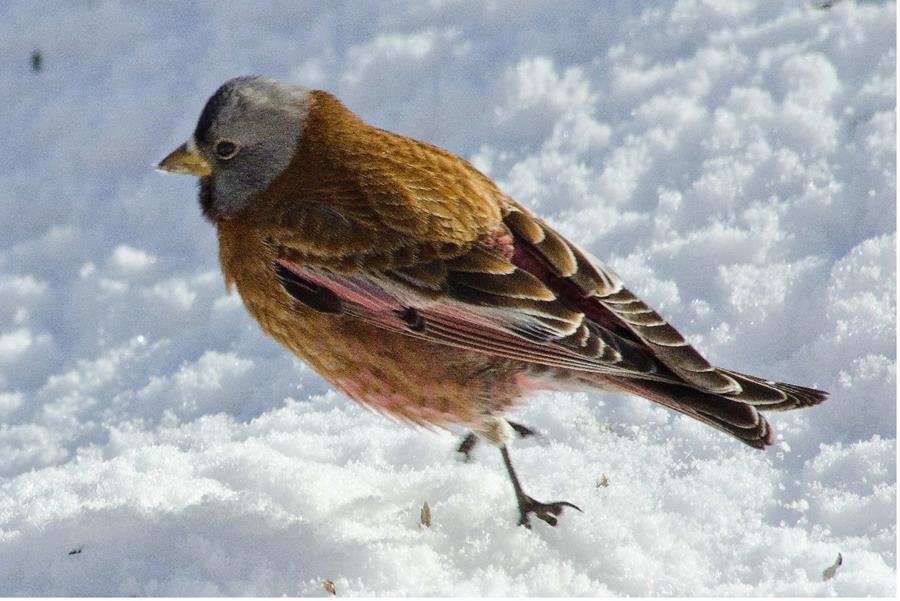Rosy-Finchers, we've got just ONE MONTH left on the project!
Feeder Count Reminders
April is our fifth and final survey window for the season. It runs from April 1 to April 30. The rosy-finches are moving towards their summer breeding territories and we’ve seen a major uptick in activity at feeders.
Don’t forget to turn in your feeder count datasheets via the Survey123 app or email us your datasheets at rosy-finchstudy@gmail.com.
** Spring Cleaning Notice Continues**
Bird feeders can be hotbeds for avian diseases that birds can spread to each other. This is why it is important to give your feeders a good cleaning 2-3 times a month. We continue to monitor our region for reports of major avian illness outbreaks at feeders and will communicate if additional actions need to be taken.
Tips on cleaning bird feeders are on Project Feeder Watch’s website.
If you see dead or sick birds, remove all feeders and bird baths for at least one month. This will help stop the spread. It’s okay if you need to cancel a feeder count! If you have questions, concerns, or want to report observations, reach out to us at rosyfinchstudy@gmail.com.
Rosy-Finch Rewards
Michelle Sagers - Logan, Utah
“I love citizen science. I actually chose it as the topic for my graduate capstone project. It's just a great and fun way to engage our communities in caring for our natural world and participate in the science behind conservation.”
Michelle Sagers on a hiking trip. Looks like nice rosy-finch nesting habitat in the background! Credit: Michelle Sagers
“I also manage a group of volunteers here in Logan, Utah at the Stokes Nature Center. This has been a fun way to get them involved in some science alongside our environmental education programs. I've really enjoyed participating in the Rosy-Finch Project because it's some built-in quiet time in my crazy life for bird and nature watching!”
Dan Hoff - Hesperus, CO
Dan has shared his home at elevation 8,450 feet near the LaPlata River with rosy-finches for 45 years. His home feeders are a hot-spot for birders in the region, some traveling hundreds of miles to see all three species of rosy-finches! It was through his visits from fellow birders he learned about the Rosy-Finch Project and joined.
Dan Hoff is one of the lucky few to have a hat trick at his feeders: he has all three species in the winter! A Gray-crowned Rosy-Finch hops along in the snow at his home. Credit: Dan Hoff
Dan says, "I have had rosy finches off and on the whole time that I have lived here. I became a more diligent feeder when I retired about 10 years ago. About 5 years ago a neighbor's house sitter was an avid birder and when she saw my herd of rosy's, she let all the birders in the area know about the excellent viewing opportunity. Since then, I have had frequent viewers, some coming from hundreds of miles away for the opportunity to see all 3 species. One of these viewers let me know about the study and I enrolled."
Get to Know the Rosy-finches: Winter Roosts
Do you ever think about where rosy-finches go on these cold winter nights? All three species will roost together in flocks, sometimes with hundreds of birds!
They find warmer, sheltered spots in caves, cracks in cliffs, pipes, railroad cars, bridges, buildings, wells, and even old swallow nests.
Rosy-finch image captured by volunteer Rob Tolley.
Do You Know the Other Mountain Finch Species?
You may be very familiar with the three rosy-finch species in North America, but can you identify the other three species within the Leucosticte genus?
These birds live throughout Asia, with ranges from India and Afghanistan to Mongolia and North Asia depending on the species. Check your answers below the photos.
Quick Links
Conduct your Feeder Counts! Last survey window is the month of April.
Enter Your Feeder Count data in Survey123 or email your datasheet torosyfinchstudy@gmail.com.





